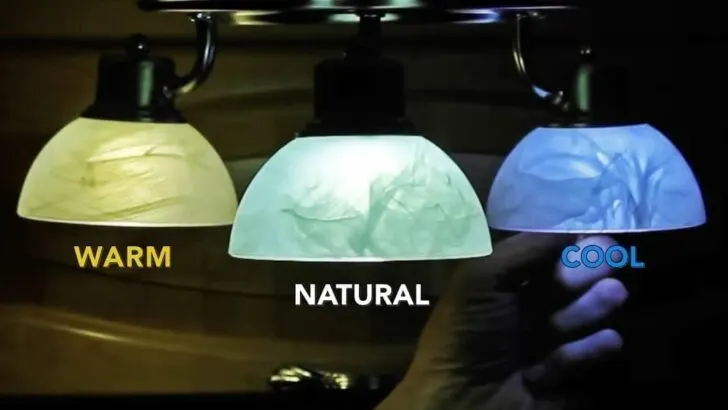Light Emitting Diodes, otherwise known as LED lights, have become the popular choice for use in recreational vehicles for numerous reasons. Your rig may still be equipped with its original incandescent/fluorescent light bulbs, but we assure you that after comparing the technologies, the first thing you’ll do is switch out all of your power-guzzling bulbs for new, efficient RV LED lights. Keep reading… we’re going to compare the two below.
RV LED Lights vs. Regular RV Bulbs
We looked hard, but could only find two things that RV LED lights and other lighting types have in common: they all utilize electricity to work, and they all light up. Other than that, RV LED lights are very different in important ways.
Why Should I Change My Current Lights to LEDs?
When looking at the “Battle of the Bulbs” differences above, it should become obvious as to why LEDs are a useful upgrade for any RV, but especially for those RVers looking to conserve energy.
First and foremost, RV LED lights use significantly less power. For instance, the small ceiling lights in an RV require incandescent bulbs that use 1.6 amps each. That same size bulb as an LED only uses .12 amps of power. If you had 12 lights on in your RV, the incandescent bulbs would use 19.2 amps, as opposed to 1.44 amps if the bulbs are replaced with LEDs. This can be enormous savings in power if you’re boondocking or using solar energy to charge your batteries.
Additionally, LED lights are much cooler to the touch, meaning there’s less chance of burns to little ones’ curious hands or accidental fires. Incandescent bulbs get hot because of their inefficiency… all of that heat is energy that ISN’T being converted to light. LEDs stay cooler because they are so much more efficient… more of the power supplied to the bulb is being converted to light, not heat.

Photo exposed to emphasize color differences
RV LED lights typically have three color choices: warm white, cool white, or natural white. This gives you more of a selection of “mood lighting,” in your RV and allows you to select which color is easier on your eyes (you can even mix and match… with different colors in different fixtures, depending upon your need):
- “Warm white” bulbs most-closely reproduce the more yellow/orange light from a typical incandescent bulb, and is usually the most pleasing to people just getting into LED lights.
- “Natural white” bulbs have a brighter, whiter light that is most like natural daylight and can be a good choice for locations where you want more light. It also happens to be our personal favorite.
- “Cool white” bulbs tend to have a blue-white color that can seem a bit “sterile” to some… but provides stronger contrast to edges, making them seem brighter than either of the other color choices.
Lastly, changing your RV bulbs from incandescent to RV LED lights couldn’t be easier. Just take off the housing on the light fixture, pop out the old, and pop in a new LED bulb. Just match the style of the bulb base from the old one to the new LED!
How to Change Your RV Lights to LEDs
If you’re leery of taking the leap, be sure to watch our video on Converting RV Lights to LEDs. It shows some of the more unusual lighting challenges and how to overcome them. Additionally, we have suggestions as to where you can find just the right LED bulbs to fit your RV.
Or you can check out ALL of our videos about LED lighting here:
Finally, we highly recommend buying RV LED lights from www.M4Products.com. This online store is where we get all of our lights and we’ve never been disappointed. When ordering online or over the phone, use discount code “RVGEEKS5” to get 5% off your entire LED purchase.
Conclusion
Today’s new technologies make it easier than ever to get great lighting in your recreational vehicle while using much less power. LED bulbs may be a bit more expensive, but we think their longer lifespan, brighter beams, light color choices, and cooler operating temperatures are all added benefits that make them a modification/upgrade that’s well worth the cost.
Geek Out With Us Every Week
Join our newsletter (signup form below) to learn about all things RV related. Every week we offer free tips, tricks, product reviews, and more to our our online community RVers. Whether this is your first time on the road or you’re a seasoned expert, we’d love for you to geek out with us!


Walter
Sunday 12th of March 2023
wanting to know if these M4 lights make a humming or vibration noise while lit? All our LED lights from Ikea in our house make a hateful noise. I just bought a batch of lights for a new RV I'm building out and noticed right away..the super annoying humm. Operating in the small space makes it even worse. The power source is a GoalZero battery bank that is supposed to have a clean output signal.
TheRVgeeks
Sunday 19th of March 2023
Hi Walter... we've never experienced any hum of any kind from the M4 bulbs we've used. But, we'd suggest ordering one to test before buying too many. Power source is usually the cause of LED buzzing/humming... so it's POSSIBLE the GoalZero's output isn't clean.
Sherry Kurzhal
Friday 8th of January 2021
We watched your YouTube video on how to convert RV florescent lights to LED and are anxious to do the same in our unit. We have been combing the net for the supplies and are going nuts trying to come up with the correct 1) roll of 12v strip lights, 2) bare end connectors and 3) silicone end caps.
I can find the roll of lights but when I look for the bare end connectors my husband says no, that won't work or they are 4 pin not 2. There is always something wrong with the options I am coming up with. I can't even find the silicone end caps. Can you the brands you used? I have M4 products but they don't seem to have the supplies for converting the lights.
TheRVgeeks
Friday 8th of January 2021
Hi Sherry! Sorry to hear you're having such trouble... but we know the issue. It can be a pain. Check out our other video about doing the LED Strip light conversion. The links there SHOULD work for you. But you need to make sure the connectors are the same width as the LED strip. We had a problem at one point, early on, where the connectors were narrower than the LED strip itself... so we had to trim the width of the strip to get it to fit. It worked, it was just extra work to get the strip inserted... and it didn't hold as well.
Saturday 28th of November 2020
5
Mike Steffy
Wednesday 25th of November 2020
The previous owner changed out the bulbs inside our RV with LED except the light above the table. It has the old light what needs to be done to change it out? I'm thinking I we have to replace out the light instead of bulbs.
TheRVgeeks
Wednesday 25th of November 2020
Hi Mike. It's hard to say without seeing the fixture. And while it's POSSIBLE that you'd have to replace the whole fixture, it's not likely. What you need to do is determine if there's a way to remove the bulb(s) from the current unit. Once you do, you can determine the base (wedge, twist-in, pin, etc) so that you can identify the correct replacement LED.
There ARE some odd, older RVs that used 120V fixtures in some locations... so be sure to confirm that it's not one of those (if that were the case, the light would only work when on shore power or running the generator or inverter).
Monday 23rd of November 2020
1